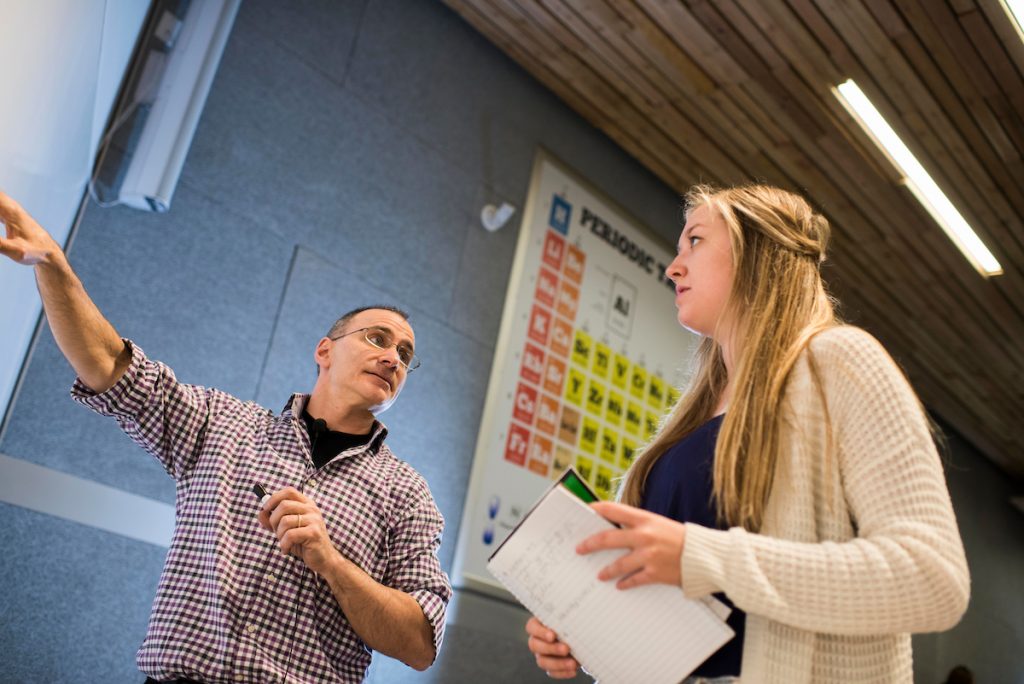By Heidi Toth
NAU Communications
Not enough people going into teaching plus half of teachers leaving the field in their first three to five years equals America’s sizable and still growing teacher shortage.
A program at Northern Arizona University, set up to provide support from when math and science education majors set foot on campus to years after they graduate, is out to combat that imbalance.
The National Science Foundation gave NAU a second grant of $1.45 million to continue a program started seven years ago that aims to recruit, train and retain well-qualified math and science teachers.
Shannon Guerrero, a professor in the Department of Mathematics & Statistics and principal investigator of the grant, said they created the Noyce Scholars program in 2010 with three separate forms of outreach and support: $15,000 scholarships for students in their final year of school; an induction program that provides continuing education and community during teachers’ first two years in the classroom; and through a sub-award, paid internships for math and science students at Maricopa County Community College District (MCCCD) to encourage them to become teachers and continue their education at NAU.
To qualify for the scholarships, teachers must spend their first two years teaching in a high-needs school district, meaning the district has a high rate of students who qualify for free or reduced lunch, a high rate of turnover in math and science teachers or a large number of math and science educators teaching out of their content area.
For this new award, the goals stay the same, but some of the details will change. Students will get $18,000 in their final year, and the induction program will be more flexible in terms of scheduling and course requirements. Teachers won’t have to pay for those credit hours—they’ll be treated as continuing education credits—but if having more education will bump up a teacher’s salary, they can earn those credits as graduate hours.
Basically, whatever Guerrero’s team can do to help teachers succeed in the classroom in those difficult early years, they’re going to do it.
“One of our main goals is to take them beyond survival mode and to keep pushing them to grow as teachers and not get caught up in the daily grind and by teaching how to continue growing as professionals and remain energized,” she said. “This program is about recruiting teachers, retaining them and serving those under-represented populations and high-needs school districts.”
The major change is in recruitment. Guerrero said the reasoning for the partnership with MCCCD was to encourage students to get interested in teaching math or science, then matriculating into NAU’s program. That didn’t happen at the levels they hoped. This time, they’ll reach out to Coconino Community College, perhaps using Noyce Scholars as ambassadors, offering tutoring, collaborating with faculty and otherwise raising awareness of teaching as a profession.
“Our sense is a lot of students who might be going through these classes have never even considered teaching as a profession,” Guerrero said. “One of the Noyce goals is to grab students early in their career and suggest they give teaching math and science a shot.”
Gauging the effectiveness of the Noyce program is difficult since graduates from the first round of scholarships have only been in the field for three to four years. In addition, the same year the Noyce Scholars program began, the Center for Science Teaching and Learning and Department of Mathematics & Statistics implemented NAUTeach for future math and science teachers, which puts the onus of educating students on how to teach on the content departments instead of the College of Education. Separating the impact of either program on the success of mathematics and science education graduates is difficult since they began at the same time and serve the same population.

“To be a math education major at NAU, you essentially get the equivalent of a full math degree. It’s intimidating,” Guerrero said. “The areas of physics, chemistry and math are intimidating for a lot of students, and schools are losing highly qualified math and science teachers, so instruction is not as good as it could be to get students interested and comfortable with math and science. Then they come to college and don’t have the skill set, interest or desire to pursue math and science.
“We’re trying to break that cycle by putting really good math and science teachers out there.”
About NAU Teach
In 2010, NAU introduced NAUTeach, a program that allows math and science education majors to do not only their content but also their education work through their departments, allowing classes to focus specifically on teaching math and science instead of general teaching. Students take courses through the College of Education as electives.
The program begins with Step 1 and Step 2 classes, a one-hour course for which students can sign up their first or second semester. These classes are open to any major and offer an opportunity for students to discover whether they like teaching. They learn about education and the theories behind teaching, then go out and teach in a local elementary or middle school. Students earn $100 upon completion of this course.
“Give this class a shot,” Guerrero advised. “Give this profession a shot.”



